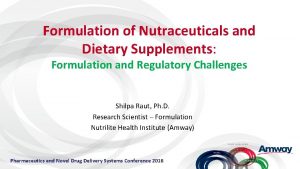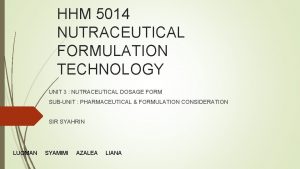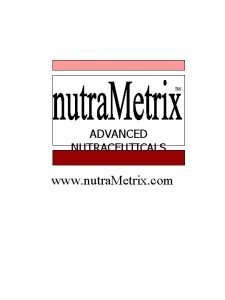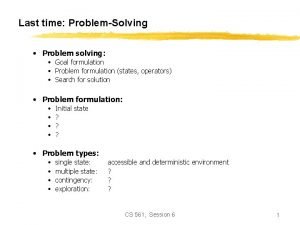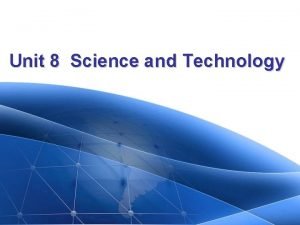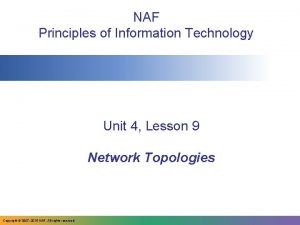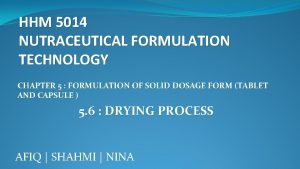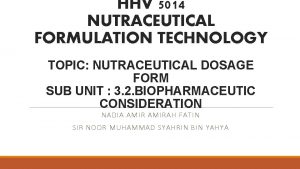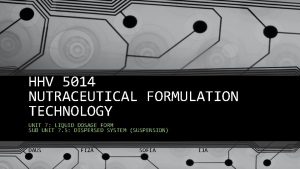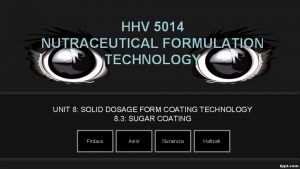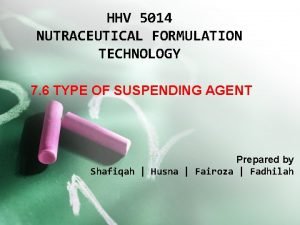HHM 5014 NUTRACEUTICAL FORMULATION TECHNOLOGY UNIT 5 FORMULATION











- Slides: 11

HHM 5014 NUTRACEUTICAL FORMULATION TECHNOLOGY UNIT 5: FORMULATION OF SOLID DOSAGE FORM (TABLETS & CAPSULE) SUB-UNIT : 5. 1 FORMULA 5. 2 THE FUNCTION OF EACH INGREDIENTS LUQMAN SYAMIMI AZALEA LIANA SIR NOOR MUHAMMAD SYAHRIN YAHYA

INTRODUCTION Pharmaceutical formulation is the process in which different chemical substances, including the active drug, are combined to produce a final medicinal product. Tablets may be defined as the solid unit dosage form of medicament or medicaments with or without suitable excipients and prepared either by moulding or by compression Capsules are solid dosage form of medication in which the drug is enclosed in either a hard or soft soluble container or shell made of gelatin.


FORMULA Ibuprofen • 200 mg Microcrystalline cellulose • 158 mg Hydroxypropyl cellulose • 32 mg Crosscarmellose sodium • 8 mg Magnesium stearate • 2 mg

INGREDIENTS Ibuprofen FUNCTION • used for treating pain, fever, and inflammation. • reducing hormones that cause inflammation and pain in the body. Microcrystalline cellulose • used as pharmaceutical excipients and disintegrating agents of tablets Hydroxypropyl cellulose • used as a rate-controlling polymer for sustained-release dose forms Crosscarmellose sodium • used to disintegrate tablet after oral administration Magnesium stearate • diluent for the manufacture of tablet, capsule, and powder dosage forms.


FORMULA Acyclovir • 200 mg HPMC K 4 M • 60 mg Sodium bicarbonate • 10 mg Succinic acid • 10 mg

INGREDIENTS FUNCTION Acyclovir • used to treat infections caused by certain types of viruses Hydroxypropyl methylcellulose • Protect valuable ingredients from stomach acid • Food additive Sodium bicarbonate Succinic acid • Used to relieving indigestion • Used to prevent heartburn • Help to increase the amount of iron in body • Improve appetite

FORMULATION OF SOFT GELATIN CAPSULES • Gelatin q Critical parameter: viscosity as measured by bloom strength q Low viscosity : thin weak films that take long time to dry q High viscosity: thick hard and often brittle films • Water q 0. 7 -1. 3 water/part gelatin • Colours and opacifiers • Plasticizers(glycerol/gelatin 0. 350. 76) q Glycerol q Sorbitol q Propylene glycol • Contents q Liquids (oils and polar liquids such as PEG) q Water and ethanol max 10% q Self emulsifying oils q Miroemulsions q Suspensions

FUNCTIONS OF INGREDIENTS OF SOFT GELATIN CAPSULES Colour- The colour that used in shell has to be darker than colour of encapsulating material. Opacifier- Usually Titanium dioxide, may be added to produce an opaque shell, when the fill formulation is a Suspension or to prevent photo degradation of light sensitive fill ingredients. Plasticizer- Used to make the soft gel elastic and pliable. Chelating agents- Iron is always present in raw gelatin and should not contain iron more than 15 ppm. It can also be used to prevent the reaction of iron with materials or colours.

CONCLUSION 1. Formulation is a mixture or a structure such as a capsule, a pill, tablet, or an emulsion, prepared according to a specific procedure (called a “formula”). 2. Formulations are a very important aspect of creating medicines, since they are essential to ensuring that the active part of the drug is delivered to the correct part of the body, in the right concentration, and at the right rate (not too fast and not too slowly). 3. Formulations for particular products that are safer, more effective, and more economical than any of their components used individually.
 Nutraceutical formulation development
Nutraceutical formulation development Nutraceutical formulation
Nutraceutical formulation Advanced nutraceuticals
Advanced nutraceuticals Why problem formulation follow goal formulation
Why problem formulation follow goal formulation Unit 10, unit 10 review tests, unit 10 general test
Unit 10, unit 10 review tests, unit 10 general test Unit 2 technology systems
Unit 2 technology systems What material does not conduct electricity
What material does not conduct electricity Cape information technology unit 1 notes
Cape information technology unit 1 notes Unit 8 technology
Unit 8 technology Unit 1 technology in use
Unit 1 technology in use Unit 1 technology in use
Unit 1 technology in use Information technology unit 4
Information technology unit 4
